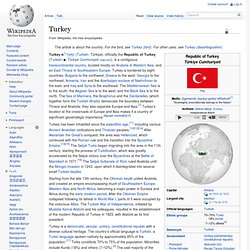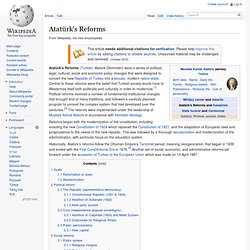

Kemalist ideology. Kemalism (Turkish: Kemalizm), also known as Atatürkism (Turkish: Atatürkçülük, Atatürkçü düşünce), or the Six Arrows (Turkish: Altı ok), is the founding ideology of Turkey.[1] Kemalism, as it was implemented by Mustafa Kemal Atatürk, was defined by sweeping political, social, cultural and religious reforms designed to separate the new state of Turkey from its Ottoman tradition and embrace a Westernized way of living,[2] including the establishment of democracy, civil and political equality for women, secularism, state support of the sciences and free education, many of which were first introduced to Turkey during Atatürk's presidency in his reforms.[3] Philosophy[edit] Kemalism is a modernization philosophy which guided the transition between multi-religious, multi-ethnic Ottoman Empire to the secular, unitary Republic of Turkey.

Kemalism sets the boundaries of the social process in the Turkish Reformation. Fundamentals[edit] Republicanism[edit] Populism[edit] Sovereignty[edit] Motto[edit] Turkey. Turkey i/ˈtɜrki/ (Turkish: Türkiye), officially the Republic of Turkey (Turkish: Turkey has been inhabited since the paleolithic age,[11] including various Ancient Anatolian civilizations and Thracian peoples.[12][13][14] After Alexander the Great's conquest, the area was Hellenized, which continued with the Roman rule and the transition into the Byzantine Empire.[13][15] The Seljuk Turks began migrating into the area in the 11th century, starting the process of Turkification, which was greatly accelerated by the Seljuk victory over the Byzantines at the Battle of Manzikert in 1071.[16] The Seljuk Sultanate of Rûm ruled Anatolia until the Mongol invasion in 1243, upon which it disintegrated into several small Turkish beyliks.

Starting from the late 13th century, the Ottoman beylik united Anatolia and created an empire encompassing much of Southeastern Europe, Western Asia and North Africa, becoming a major power in Eurasia and Africa during the early modern period. Etymology History. Atatürk's Reforms. Atatürk's Reforms (Turkish: Atatürk Devrimleri) were a series of political, legal, cultural, social and economic policy changes that were designed to convert the new Republic of Turkey into a secular, modern nation-state.

Central to these reforms were the belief that Turkish society would have to Westernize itself both politically and culturally in order to modernize.[1] Political reforms involved a number of fundamental institutional changes that brought end of many traditions, and followed a carefully planned program to unravel the complex system that had developed over the centuries.[2] The reforms were implemented under the leadership of Mustafa Kemal Atatürk in accordance with Kemalist ideology. Reforms began with the modernization of the constitution, including enacting the new Constitution of 1924 which replaced the Constitution of 1921, and the adaptation of European laws and jurisprudence to the needs of the new republic. Goals[edit] The Sultan says: "[For God's sake!] Treaty of Sèvres. The representatives signed the treaty in an exhibition room at the famous porcelain factory[4] in Sèvres, France.[5] The treaty had four signatories for the Ottoman Empire: Rıza Tevfik, the grand vizier Damat Ferid Pasha, ambassador Hadi Pasha, and the minister of education Reşid Halis, who were endorsed by Sultan Mehmed VI.

Among the other Allied powers, Greece did not accept the borders as drawn and never ratified it.[6] Avetis Aharonian, the President of the Delegation of the First Republic of Armenia, which also signed the Treaty of Batum on 4 June 1918, was a signatory of this treaty. Aims of the Allies[edit] The leaders of France, Britain, and the United States had stated their differing objectives with respect to the Ottoman Empire during the Paris Peace Conference, 1919.
The common theme was the sick man of Europe had come to his own end. Treaty terms[edit] An original map from 1920 illustrating the Treaty of Sèvres region. Kingdom of Hejaz[edit] Armenia[edit] Ottoman Empire[edit] Who is Mustafa Kemal Atatürk?